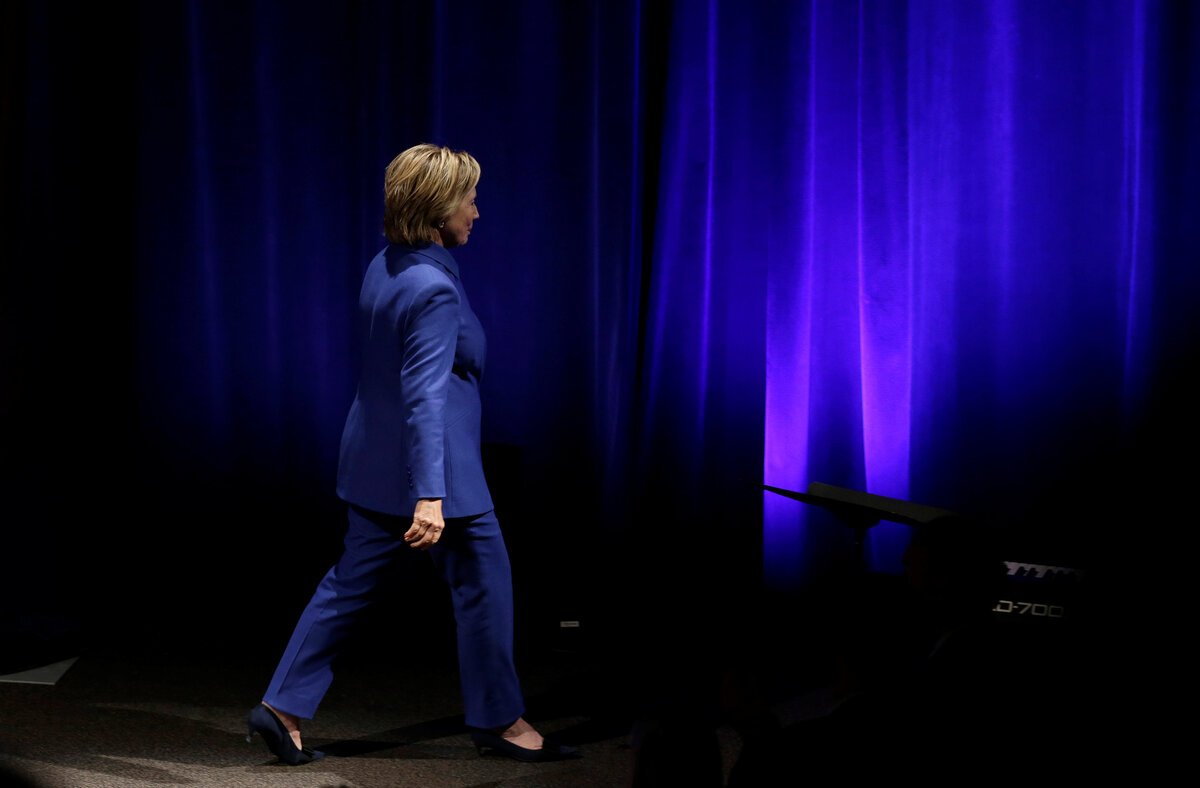Why Hillary Clinton lost the white women's vote
Loading...
| Washington
Something strange, it seems, happened on the way to Hillary Clinton’s failed effort to become the first woman president of the United States: She lost the white women’s vote.
“Seems” is the operative word here. Mrs. Clinton won the overall women’s vote, 54 percent to 42 percent, reflecting the longstanding gender gap that gives Democratic candidates an edge with female voters. But among voters most like Clinton – white women – she lost, .
Why this happened, and what it tells us about the state of “identity politics,” is instructive.
Like all voters, women vote the way they do for a host of reasons, including the issue positions, character traits, and experience of the candidates. For some, the prospect of electing the first woman president was deeply meaningful; for others, not so much. To some women supporters, Clinton’s gender was even a negative: What if she failed? That could set women back, said female voters in a focus group last summer.
In principle, Americans have long been ready to elect the first woman president. By 1999, that 92 percent of Americans were willing to vote for a “generally well-qualified woman” for president.
But when presented with a real opportunity to put a woman in the Oval Office, millions of women said either “no thanks” or, more emphatically, “no way.” The problem wasn’t Clinton’s gender, they said, it was her. In electing the first woman president, it had to be the right woman. And besides, some voters said, women have been shattering glass ceilings in many spheres – world politics, business, the military – for a long time.
“It’s meaningful” that Clinton is a woman, “but that was 20 or 30 years ago. We’re past that,” said Debbie P., a middle-aged Trump voter in Bucks County, Penn., at a polling place on Election Day. “Didn’t Maggie Thatcher [and] Golda Meir crash the glass ceiling?” she added, referring to the late prime ministers of Britain and Israel.
During the Democratic primaries, millions of women of all ages went for Bernie Sanders - at times in spite of gender, but most assuredly because of his anti-establishment, progressive appeal. And while most Sanders voters came “home” to Clinton in the general election, some did so grudgingly. Others refused.
Long before Election Day, political scientist Jennifer Lawless at American University suspected that resistance to Clinton was not for the most part a result of sexism.
“People have vehement reactions to her in one direction or another, and have for 20 years,” Ms. Lawless, an expert on women and politics, told the Monitor last year. “So I’ve often said that if people are fundamentally opposed to her, I’m not convinced that it’s sexism; it could be ‘Clinton-ism.’ ”
“Clinton-ism” could be defined as the entire complex of issues surrounding her decades in the public eye. Since she first burst onto the national scene in 1991 as the wife of Democratic presidential candidate Bill Clinton, Hillary Clinton has been both a trailblazer and a magnet for controversy. Years later, in her second run for president, she remained both. This time around, it was the constant drip of questions around the Clinton family foundation and her private email system as secretary of State that bogged her down. Many voters, too, were just plain ready for an outsider.
Still, some observers cite gendered factors behind Clinton’s downfall. points to “self-loathing” white women willing to vote for a man who bragged about sexually aggressive behavior toward women. A former Clinton communications official cites “.”
Conservative commentator Amanda Carpenter, one of the original #NeverTrump-ers, sees a whole complex of issues that sank Clinton.
“If anyone wants to blame women for Clinton’s loss, they ought to start with Hillary Clinton,” writes Ms. Carpenter, former communications director for Sen. Ted Cruz (R) of Texas, .
For starters, Carpenter blames her policy proposals, messaging, misleading statements about her emails, and miscalculations on where to campaign.
“Don’t say Clinton was disadvantaged because she was a woman, because as a Clinton she had every advantage possible,” says Carpenter, who also refused to vote for Clinton. “She had money, the staff, the ads, and institutional support needed for a successful run. And, she still blew it, folks.”
Other observers say that gender couldn’t help but play a role in how voters assessed Clinton. Imagine her saying or doing any of the outrageous or controversial things Donald Trump did during the campaign, .
In some ways, women politicians are becoming “just like the guys.” This cycle, for the first time, both major parties ran credible female candidates, including Carly Fiorina on the Republican side.
Even the recent legal troubles of former Pennsylvania Attorney General Kathleen Kane and former Rep. Corinne Brown (D) of Florida show that women politicians are not immune to the full range of experiences of male politicians. But at the same time, women politicians are still held to a higher standard on measures of honesty, a phenomenon known as the “character pedestal,” says Democratic pollster Celinda Lake.
In her 2016 race, Clinton emphasized gender much more than she did in her 2008 presidential campaign. But maybe that didn’t matter. Either way, it didn’t deliver victory. She did win the national popular vote by more than a million votes, but in the column that mattered, the Electoral College, she fell far short after surprise losses in the Rust Belt. For many working-class white voters, economic challenges and cultural differences trumped gender.
Still, for many older women who had long dreamed of seeing the first woman president, just getting to vote for Clinton was a moment to savor.
At 2 p.m. on Election Day, on Manhattan’s Upper West Side, septuagenarian Ann Gora shuffled out of the polling place with her 16-year-old mixed-breed beagle, Diesel. When asked about her vote, she says, “Hillary Clinton – it’s a historic event.” And then she began to weep.
“I think she really knows how to do things, and once all this dust settles down, I hope she will be able to reach across the aisle,” says Ms. Gora. “I know in the past she was really, really good at working with all sorts of people from all walks of life and different political beliefs, and I think she will be able to do that as president.”
Within hours, the outcome would be known. President Hillary Clinton was not to be. But just as Clinton’s first presidential run put more cracks in the highest, hardest glass ceiling, so too did her second. And someday, voters on both sides of the aisle believe, a woman will come along capable of shattering it completely.
Staff writers Francine Kiefer and Harry Bruinius contributed to this report from Bucks County, Penn., and New York City.





